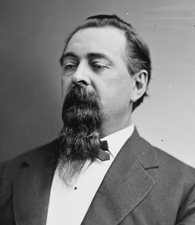Romualdo Pacheco, born October 31, 1831, was the first Hispanic representative of a state in Congress and to date, California’s only Latino governor.
Romualdo Pacheco’s Early Days
Born in Santa Barbara 19 years before California became a state, Jose Antonio Romualdo Pacheco was originally a Mexican citizen. His father died defending the Mexican governor of California at the first Battle of Cahuenga Pass five weeks after Pacheco’s birth on October 31, 1831. His mother remarried, to a Scottish captain. As a young child, Pacheco was sent to boarding school in Hawaii, where he learned English and French, but forgot his native Spanish.
Returning to the mainland when he was 12, Pacheco relearned Spanish and was sent to apprentice on a cargo ship.
While sailing a shipping route along California’s coast, Pacheco’s ship, a Mexican freighter, was captured by the U.S.S. Cyane. Pacheco was only released once he swore allegiance to the United States and signed an oath confirming his citizenship. At age 17, Pacheco sought his fortune as a rancher during the Gold Rush of 1848.
Sources in this Story
- Library of Congress: Hispanic Americans in Congress: Romualdo Pacheco
- The California State Military Museum: Governor Jose Antonio Romualdo Pacheco, Jr.
- Governors of California: Romualdo Pacheco
- Biographical Directory of the United States Congress: Pacheco, Romualdo
- El Puente: El portaretrato de Romualdo Pacheco (R-Ca) quien fue un pionero politico y primer representante Hispano, tomó un lugar de honor en el Capitolio.
Pacheco’s Notable Accomplishments
Just four years after California became a state, Pacheco was elected one of its officials; he was voted San Obispo County judge in 1854. With his status as a California native and his proficiency in both Spanish and English, Pacheco appealed to the state’s longtime residents and new settlers alike.
Within three years Pacheco parlayed his local success into a seat on the state Senate in 1857 as a Democrat, winning re-election in 1861 as a member of the Union party and in 1869 as a Republican. Governor Leland Stanford made Pacheco a brigadier general in 1861, and he commanded the state militia’s First Brigade and formed the First Battalion of Native Cavalry of the California Volunteers. That cavalry was instrumental in disarming all non-Union military companies in Los Angeles County in 1862.
In addition, the governor nominated him as state treasurer in 1863, and he remained at that post until 1866. Pacheco became lieutenant governor in 1871, and during his term, he also served as prison warden at San Quentin.
Governor Newton Booth was elected to the U.S. Senate in 1875, and Pacheco assumed the position of governor of California, making him the first and to date, the only Latino to hold that position in that state. After nine months spent as the 12th governor of California—during which time he pardoned 79 inmates and helped to develop the University of California—Pacheco ran for reelection as a member of the People’s Independent Party and lost.
The following year, Pacheco ran as a Republican for the United States House of Representatives and won by one vote—19,104 to 19,103. His opponent contested the election, but Pacheco was sworn in. He was appointed to the Committee on Public Lands and served for less than four months before the House Committee on Elections ruled that he had not won his election and gave his seat to his opponent.
Pacheco headed home to California but did not stay for long. Two years later, in 1879, he was reelected to the House, where he stayed for two terms. Although Hispanic officials had previously represented territories in the U.S. Congress, Pacheco was the first to represent a state. He was also the first Hispanic Representative to chair a committee, heading up the Committee on Private Land Claims.
The Rest of the Story
One of Pacheco’s claims to fame is his status as the only California governor to ever lasso a grizzly bear, a story that speaks to his love of ranching and the outdoors. After he retired from the House, Pacheco managed a large Mexican cattle ranch for five years. He also continued to serve his country as Envoy Extraordinary and Minister Plenipotentiary to the Central American States.
For much of the rest of his life, he remained in these roles, maintaining diplomatic relationships with the countries of Central and South America. Pacheco died January 23, 1899 in Oakland, California, at the age of 67, after suffering from liver trouble. Pacheco’s portrait now hangs in the United States Capitol Building in Washington, D.C.
This article was originally written by Jennifer Ferris; it was updated October 26, 2017.











